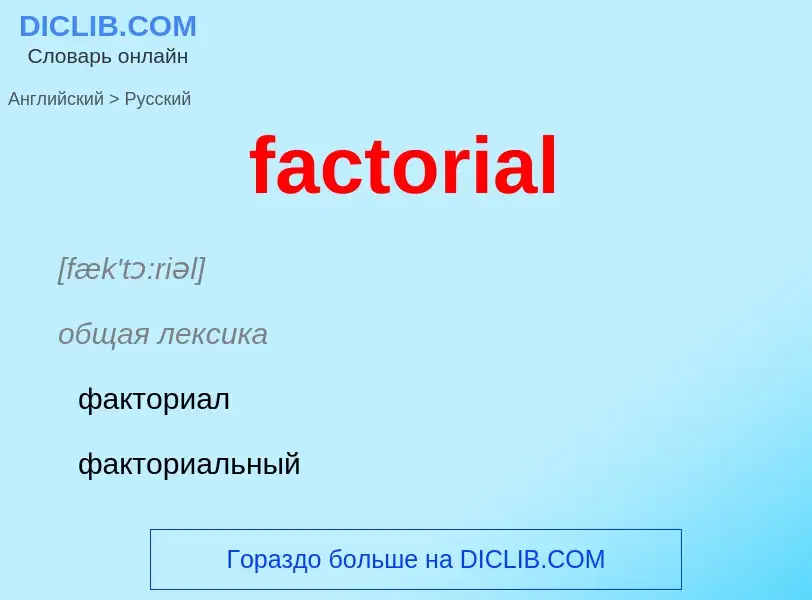Translation and analysis of words by ChatGPT artificial intelligence
On this page you can get a detailed analysis of a word or phrase, produced by the best artificial intelligence technology to date:
- how the word is used
- frequency of use
- it is used more often in oral or written speech
- word translation options
- usage examples (several phrases with translation)
- etymology
factorial - translation to English
[fæk'tɔ:riəl]
общая лексика
факториал
факториальный
генный
математическое выражение, обозначаемое как n!, означающее результат последовательного умножения целых чисел от 1 до n, т.е. 1x2?3?...?(n-1)?n
факторный
Смотрите также
прилагательное
общая лексика
комиссионерский
посреднический
математика
факториальный
статистика
факторный (об эксперименте)
редкое выражение
фабричный
существительное
[fæk'tɔ:riəl]
математика
факториал
статистика
факторный эксперимент
2) факторный
Definition
Wikipedia
In mathematics, the factorial of a non-negative integer , denoted by , is the product of all positive integers less than or equal to . The factorial of also equals the product of with the next smaller factorial:
For example, The value of 0! is 1, according to the convention for an empty product.Factorials have been discovered in several ancient cultures, notably in Indian mathematics in the canonical works of Jain literature, and by Jewish mystics in the Talmudic book Sefer Yetzirah. The factorial operation is encountered in many areas of mathematics, notably in combinatorics, where its most basic use counts the possible distinct sequences – the permutations – of distinct objects: there are In mathematical analysis, factorials are used in power series for the exponential function and other functions, and they also have applications in algebra, number theory, probability theory, and computer science.
Much of the mathematics of the factorial function was developed beginning in the late 18th and early 19th centuries. Stirling's approximation provides an accurate approximation to the factorial of large numbers, showing that it grows more quickly than exponential growth. Legendre's formula describes the exponents of the prime numbers in a prime factorization of the factorials, and can be used to count the trailing zeros of the factorials. Daniel Bernoulli and Leonhard Euler interpolated the factorial function to a continuous function of complex numbers, except at the negative integers, the (offset) gamma function.
Many other notable functions and number sequences are closely related to the factorials, including the binomial coefficients, double factorials, falling factorials, primorials, and subfactorials. Implementations of the factorial function are commonly used as an example of different computer programming styles, and are included in scientific calculators and scientific computing software libraries. Although directly computing large factorials using the product formula or recurrence is not efficient, faster algorithms are known, matching to within a constant factor the time for fast multiplication algorithms for numbers with the same number of digits.


![TI SR-50A]], a 1975 calculator with a factorial key (third row, center right) TI SR-50A]], a 1975 calculator with a factorial key (third row, center right)](https://commons.wikimedia.org/wiki/Special:FilePath/Vintage Texas Instruments Model SR-50A Handheld LED Electronic Calculator, Made in the USA, Price Was $109.50 in 1975 (8715012843).jpg?width=200)
